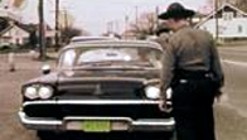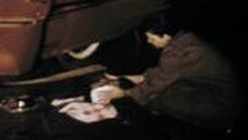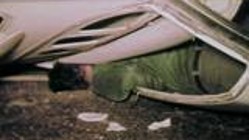|
__ __
__ __ __ __
__ __ __ __
__ __ __ __
__ __ __
"This
is not a Hollywood production as can be
readily seen. The quality is below their
standards. However, most of these scenes
were taken under adverse conditions.
Nothing has been staged. These are
actual scenes taken immediately after
the accidents occurred. Also unlike
Hollywood, our actors are paid nothing.
Most of the actors in these movies are
bad actors and received only top billing
on a tombstone. They paid a terrific
price to be in these movies. They paid
the price with their lives..."
__ __
__ __ __ __
__ __ __ __
__ __ __ __
__ __ __
Signal
30 is the radio call-code that authorities
use to designate a traffic accident with
fatalities. And that's what the majority
of this short involves; showing us --
without blinking, the results of metal
meeting metal at high rates of speed, and
what's left of the drivers that are pried
out of the resulting wreckage. Most of the
Driver's Ed shorts I remember watching
usually saved the real carnage for the end
as a final punctuation mark on the dangers
found on the road. But not with Signal
30.
Heck no. Here, what borderlines as
atrocity footage is used as a hammer to
bludgeon us into remembering the Three-Es
of highway safety: Education, Enforcement
and Engineering.

And
after a brief look at police training,
routine traffic stops, general violations,
and a couple of near misses, the accident
footage comes fast and furious and brutal. And though
most accidents featured are due to
driver's negligence, the indifferent
narrator is so scathing in his delivery
that you begin to question his humanity.
And
that's about it, really.
The
End
You
can keep your Faces
of Death.
I survived Driver's Ed!
My
first experience with this type of road
safety film was back in grade school. But
instead of four-wheels of death, we got
the watered down, two-wheeled version on
bicycle safety. First came a lecture from
the creepily-bionical "Mike the
Talking Bike", with his evil visage
that lit up every time he spoke -- his
face being a cardboard box with a smiley
face carved into it, with a light bulb
stuck inside, mounted on the handlebars.
It was supposed to be friendly looking,
but it sure looked demonic to me. After
that came the slide presentation, where
the improper use of a bicycle
usually resulted in a comical accident
that generated a roar of laughter from the
audience. No dead bodies this time --
thank you, Santa.

It
wasn't until later, in high school, and
the dreaded Driver's Ed class that I
caught my first glimpse of blood on the
asphalt. I don't recall the name of the
film, but it wasn't quite as harsh and,
like I mentioned before, only concluded
with a few brief scenes of actual auto
accidents. Then, in my junior year, during
what I like to call my lawless period, I
found myself arrested and stuck in a
diversionary program. (What was I
arrested for? I'll never tell -- but it
wasn't for an MIP or DUI.) And
it was here that I saw Signal
30
for the first and, what I assumed to be,
only time until I recently tracked it down
for this retrospective.
Even
for a Driver's Ed scare film there isn't
much of a plot to Signal
30.
Luckily,
the film is [in theory] a fairly brief 28-minutes long
but about twenty-five of it is just
gratuitous. Any longer and some of us with
weaker constitutions -- when the carnage
is all too real, might have lost it.
Under
the guise of serving a public need, the
Mansfred, Ohio based Highway Safety
Foundation is legendary for it's mass
production of these orgies of death and
twisted metal littering our nations
highways: Wheels
of Tragedy, Mechanized Death, and
Highways of Agony,
to name a few, were high on the
moralizing, overshadowing the lessons to
be learned, and reinforcing these notions
with actual footage of real accidents and
mangled bodies -- topped off by the
moaning and wailing of the injured and
dying.

Under
the direction of Richard "Dick"
Wayman, these films pulled no punches and
were made with the assistance of the Ohio
State Patrol. Wayman was rumored to be an
insomniac, and with camera in hand, was
always ready, willing, and able to go and
film these accident scenes at a moments
notice. The
HSF also dabbled in filming police
procedurals and training films, and the
foundation gained some notoriety in the
1950's for assisting and documenting a few
late night police raids on several highway
rest areas, bushwhacking and arresting
rendezvousing homosexuals in the
restrooms. Somewhat ironically, Wayman and
the HSF
would later come under fire for allegedly
funneling money to make some pornographic
movies.
It
was around the same time that Signal
30
-- it's own kind of porn, in a way -- was
cobbled together. And there is a fine line
between trying to do good, and getting
your rocks off looking at death and
destruction, and this film kinda rubs you
the wrong way after awhile. They try to
sanitize it by taking the moral high
ground with the police procedural and
family notification stuff, but I don't buy
it. The camera spends way too much time
lingering on the carnage, well after the
point is made.

Why?
Why would anyone force anybody to watch
this kind of stuff in the name of
education?
The
optimist in me would believe that the
adults have our safety in mind, trying to
teach us one of life's hard lessons that
actions have consequences. The skeptic is
-- well, skeptical, and thinks parents
back then were just as scared of their
kids as those kids are now terrified of
their own offspring today -- and the only
way to get through to them is to scare 'em
straight. The
origin of these kinds of short films
actually began back in the 1930's, when
factories owners, in cahoots with their
insurance providers, began to produce
safety procedurals for their workers. Did
they have the worker's safety in mind, or
were they trying to shift accident
liability from themselves onto the
workers?
The
other shorts we've seen so far in this
ATOMIC-Wedgies retrospective are easy to
laugh and poke fun at. Most Driver's Ed
scare films are, too -- and I think The
Last Date
is the epitome of the genre -- until they
go over the line. When they start to
resemble a snuff film, then there's
nothing really to laugh at as far as I'm
concerned. These are real people. And
these people are injured -- or dead, and I
find no pleasure in other people's pain
and misery. Sorry. If that makes me a
prude; fine. So be it. I'm cool with that.
You
see, things change when they hit a little
too close to home. I lost my oldest
sister, Chris, back in 1978 when she died
in a car wreck. I was also the one who
answered the door when the police arrived
to notify us she was gone. I was also
unfortunate enough to see footage of her
flattened vehicle on the ten o'clock news,
and it's an image that was seared into my
seven-year-old brain that I'll never be
able to get rid of. For as most memories
of my sister fade away, a clear mental
picture of that flattened, tan, two-door,
Cutlass Supreme still haunts me to this
day.
|